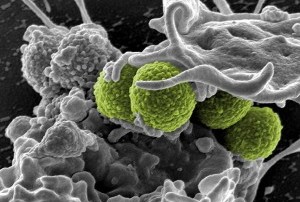 It seems like every few months the news comes out with another story about superbugs, and the once innocent locations that they can now be found in. After decades of overprescribing antibiotics to people and livestock, they’re starting to win the arms race against our medical system, and every time I hear about them, it seems like science has found these pathogens in a scary new place. So I thought to myself, is anyone keeping track of this? Is anyone documenting all of the places and things that these superbugs have contaminated?
It seems like every few months the news comes out with another story about superbugs, and the once innocent locations that they can now be found in. After decades of overprescribing antibiotics to people and livestock, they’re starting to win the arms race against our medical system, and every time I hear about them, it seems like science has found these pathogens in a scary new place. So I thought to myself, is anyone keeping track of this? Is anyone documenting all of the places and things that these superbugs have contaminated?
I’m sure there’s a CDC database somewhere that’s keeping track of this, but I can’t seem to find a definitive list online. Fortunately, that ends today. Let’s take a look at a few of the places and things that these critters have been known to occupy.
- Hospitals are currently the epicenter of superbug infections. It’s a place where people arrive with weakened immune systems, get prescribed with antibiotics, and make contact with lots of staff and other sick people. It’s the perfect breeding ground, and it’s where superbugs often make their first appearance.
- Dozens of fire stations in Washington were found to be housing MRSA and MSSA, and twelve stations reported having staff infected with MRSA.
- Gyms are an excellent breeding ground for any pathogen, and superbugs have been known to easily spread in these facilities for many years now.
- Most recently, Consumer Reports tested 458 pounds of ground beef from over a hundred grocery stores across the country. They found that 10% contain staphylococcus aureus. Organic beef was less likely to carry staph, which isn’t so surprising since those cows aren’t given antibiotics.
- Cows that are given antibiotics, however, can also produce milk that’s laden with superbugs.
- The elderly are probably the most vulnerable population to superbugs, so it’s not surprising that these bugs are downright prolific in nursing homes.
- A Canadian news station tested 54 hotel rooms across 6 major hotel chains and found traces of antibiotic-resistant bugs in all of them. Faucets, remote controls, sinks, and toilets were the most frequently contaminated.
- While MRSA makes all of the headlines, it’s easy to forget that any pathogen can achieve superbug status. In 2011, an antibiotic-resistant strain of gonorrhea was discovered in Japan, which was quickly dubbed “super gonorrhea” (Who names these things?)
- And finally, superbugs may soon make an appearance in the worst possible place: Your water supply. Many of the pharmaceuticals we consume aren’t fully metabolized by our bodies, and often find their way into water treatment plants. These facilities aren’t equipped to filter these drugs, so the antibiotics we consume have the potential spawn superbugs in our drinking water. Worst of all, some researchers have found that the chlorine in our treatment plants can make antibiotics even more potent, and help them create these resilient pathogens.
However, there’s a good chance that none of this matters for some of you. About 2-10 percent of you reading this already carry MRSA without showing any symptoms. All told, about 80,000 people are infected with MRSA, and over 11,000 die every year in America. Fortunately, that number is declining, but MRSA is just one superbug that has arguably been around the longest, so it has had plenty of time to spread. There are many more resistant bugs waiting in the wings, and by 2050 they may be killing more people than cancer does today.
Truly, superbugs are no longer just some strange phenomenon. They’ve gone mainstream, and they are pretty much everywhere now.
This article was originally published at Ready Nutrition™ on August 29th, 2015







Pharma industry loves this.
Scary! Which is why I’m already a germaphobe.